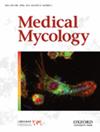苏丹真菌性鼻炎中黄曲霉菌分离物的黄曲霉毒素图谱
IF 2.7
3区 医学
Q3 INFECTIOUS DISEASES
引用次数: 0
摘要
黄曲霉是干旱地区常见的真菌性鼻炎病原体。众所周知,黄曲霉菌会产生黄曲霉毒素,对人类健康构成重大威胁。本研究旨在调查苏丹引起鼻炎的黄曲霉菌分离物的黄曲霉毒素特征。共研究了 93 个临床黄曲霉分离株和 34 个环境黄曲霉分离株。在不同温度和底物条件下,通过表型(薄层色谱法和高效色谱法)和基因型方法对黄曲霉毒素谱进行了评估。此外,还分析了黄曲霉毒素的基因表达。通过高效液相色谱法,共有 42/93 株(45%)分离物对黄曲霉毒素 B1 和 AFB2 呈阳性。当培养温度从 28℃ 升至 36℃ 时,阳性分离物的数量下降到 41%(38/93)。基因分析表明,85%(79/93)的临床分离物具有所有七种黄曲霉毒素生物合成相关基因,而 27%(14/51)的非生产分离物缺乏特定基因(aflD / aflR / aflS)。在黄曲霉毒素生产者和非生产者中都观察到了 aflS 和 aflR 基因的突变。aflD和aflR的基因表达量在沙保鲁培养基上培养的第4-6天和RPMI培养基上培养的第9天最高。黄曲霉临床分离株具有黄曲霉致病能力,这受培养温度和底物的影响。随着时间的推移,aflD 和 aflR 基因的动态表达模式丰富了我们对黄曲霉毒素生产调控的认识。总体研究结果强调了苏丹患者感染黄曲霉毒素对健康造成的风险,并强调了监测黄曲霉毒素暴露的重要性。本文章由计算机程序翻译,如有差异,请以英文原文为准。
Aflatoxin Profiles of Aspergillus flavus Isolates in Sudanese Fungal Rhinosinusitis
Aspergillus flavus is a commonly encountered pathogen responsible for fungal rhinosinusitis (FRS) in arid regions. The species is known to produce aflatoxins, posing a significant risk to human health. This study aimed to investigate the aflatoxin profiles of A. flavus isolates causing FRS in Sudan. A total of 93 clinical and 34 environmental A. flavus isolates were studied. Aflatoxin profiles were evaluated by phenotypic (thin-layer and high-performance chromatography) and genotypic methods at various temperatures and substrates. Gene expression of aflD and aflR was also analyzed. A total of 42/93 (45%) isolates were positive for aflatoxin B1 and AFB2 by HPLC. When incubation temperature changed from 28°C to 36°C, the number of positive isolates decreased to 41% (38/93). Genetic analysis revealed that 85% (79/93) of clinical isolates possessed all seven-aflatoxin biosynthesis-associated genes, while 27% (14/51) of non-producing isolates lacked specific genes (aflD / aflR / aflS). Mutations were observed in aflS and aflR genes across both aflatoxin-producers and non-producers. Gene expression of aflD and aflR showed the highest expression between the 4th and 6th days of incubation on Sabouraud medium and on the 9th day of incubation on RPMI medium. Aspergillus flavus clinical isolates demonstrated aflatoxigenic capabilities, influenced by incubation temperature and substrate. Dynamic aflD and aflR gene expression patterns over time enriched our understanding of aflatoxin production regulation. The overall findings underscored the health risks of Sudanese patients infected by this species, emphasizing the importance of monitoring aflatoxin exposure.
求助全文
通过发布文献求助,成功后即可免费获取论文全文。
去求助
来源期刊

Medical mycology
医学-兽医学
CiteScore
5.70
自引率
3.40%
发文量
632
审稿时长
12 months
期刊介绍:
Medical Mycology is a peer-reviewed international journal that focuses on original and innovative basic and applied studies, as well as learned reviews on all aspects of medical, veterinary and environmental mycology as related to disease. The objective is to present the highest quality scientific reports from throughout the world on divergent topics. These topics include the phylogeny of fungal pathogens, epidemiology and public health mycology themes, new approaches in the diagnosis and treatment of mycoses including clinical trials and guidelines, pharmacology and antifungal susceptibilities, changes in taxonomy, description of new or unusual fungi associated with human or animal disease, immunology of fungal infections, vaccinology for prevention of fungal infections, pathogenesis and virulence, and the molecular biology of pathogenic fungi in vitro and in vivo, including genomics, transcriptomics, metabolomics, and proteomics. Case reports are no longer accepted. In addition, studies of natural products showing inhibitory activity against pathogenic fungi are not accepted without chemical characterization and identification of the compounds responsible for the inhibitory activity.
 求助内容:
求助内容: 应助结果提醒方式:
应助结果提醒方式:


